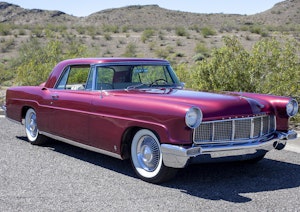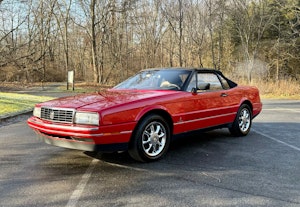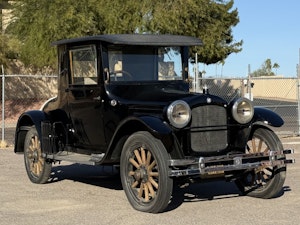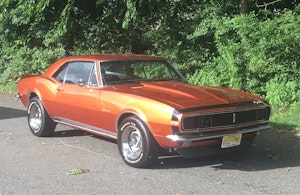Final Parking Space: 1985 Volvo 244 with nearly 400K miles
Please welcome our newest columnist (and junkyard hunter extraordinaire), the great Murilee Martin. He has been writing about cars since starting as a catalog copywriter at Year One in 1995. He became a contributor for Jalopnik in 2007 and has since written for Autoweek, Motor Authority, The Truth About Cars, Autoblog, Car and Driver and others. Murilee has loved going to junkyards since he got his first hooptie car, a $50 Toyota Corona sedan, and he enjoys speculating on the lives led by junkyard vehicles and their owners. His personal fleet at present includes a 1941 Plymouth hill-climb race car, a chopped-and-shaved 1969 Toyota Corona lowrider, a 1996 Subaru Sambar kei van, a 1997 Lexus LS400 Coach Edition and a 1981 Honda Super Cub. -EW
Now that I’ve documented more than 2600 vehicles in car graveyards around the country, I know which discarded cars to check for odometers showing intergalactic final readings: Mercedes-Benz diesels, 1980s Honda Accords and brick-shaped Volvos. Today’s Final Parking Space machine is one of the latter type: a sensible Swedish sedan that traveled the equivalent of 15.7 trips around Earth’s equator during its career.
Because some Volvo experts might be annoyed that I’m not using the same designation that Volvo assigned this car when it was new, please be aware that the true model name of this car was “DL Sedan.” That’s because United States-market members of the Volvo 200 Series cars (which included the six-cylinder 260s as well as four-cylinder 240s) were just badged as their trim levels here for the 1980 through 1985 model years; after that, they were badged with “240” followed by the trim level. Because it’s helpful to have a model name that indicates both the number of doors and the number of cylinders, most people today use the original naming system with the middle digit indicating number of engine cylinders and the third digit representing the number of doors.
Now, let’s talk about odometers! Very few vehicle manufacturers used six-digit odometers on their U.S.-market products prior to the middle 1980s, and most Detroit manufacturers kept five-digit units in their vehicles until fairly deep into the 1990s (with notable exceptions). Mercedes-Benz and Volvo, however, felt sufficiently optimistic about the longevity of their cars to go to six-digit odometers during the 1960s, while Toyota and Honda took the jump in the early 1980s. That means that I’m certain to have walked right by many American-made cars and trucks (especially trucks) in junkyards that had, say, 492,533 miles rather than the 92,533 miles displayed on their odometers. Keep that in mind before you blow a brain gasket over the shortage of Detroit Iron in the Murilee Martin Junkyard Odometer Standings.
Marketplace
Buy and sell classics with confidence
So, those standings as of the time of this writing, after nearly 17 years of writing about junkyard cars:
1. 1990 Volvo 240 DL, 631,999 miles
2. 1988 Honda Accord LXi, 626,476 miles
3. 1987 Mercedes-Benz 190E, 601,173 miles
4. 1996 Toyota Camry Wagon, 583,624 miles
5. 1981 Mercedes-Benz 300SD, 572,139 miles
6. 1985 Mercedes-Benz 300SD, 525,971 miles
7. 1988 Honda Accord DX, 513,519 miles
8. 1990 Volvo 740 Turbo Wagon, 493,549 miles
9. 1990 Nissan Sentra, 440,299 miles
10. 1991 Honda Accord, 435,417 miles
As you can see, today’s Volvo doesn’t come close to reaching the Top Ten (it’s 23rd overall at the moment, between a 393K-mile Mazda RX-7 and a 389K-mile Toyota Avalon), but some consolation for fans of Swedish steel must come from the fact that a 244 is the current Numero Uno. Today’s FPS entry is the fourth-best-traveled Volvo I’ve found in a wrecking yard, if you must know.
I couldn’t decipher this car’s odometer when I first found it, however, because there was an object blocking most of the digits. I could see it began with 3, but I had to know the true figure.
I never visit a junkyard without my trusty lightweight toolkit, naturally, so I got to work removing and disassembling this car’s instrument cluster (don’t worry, I put it back together again in case a later junkyard shopper wanted to buy it).
It turned out that a piece of the label affixed by VDO during the manufacture of the cluster (in November of 1984) had suffered adhesive failure and slipped in front of the odometer. This car was in a San Francisco Bay Area yard, so we can assume that California’s hot, dry summer weather was out of spec for the label glue VDO used.
The 240 is the most iconic and best-known Volvo, period, and it was available in the United States from the 1975 through 1993 model years. It proved so popular that it stayed in production long past its intended successor, the 740.
The 240’s ancestry goes much further back than 1975, though. From the A-pillar rearward, it’s essentially a Volvo 140, a 1960s design that itself carries some DNA from the 1944 Volvo PV444. The 240 uses a suspension design very similar to that of Ford’s Fox-body Mustang and is about the same size and weight, so its performance is notably Fox-like when given a Ford Windsor V-8 swap (as I’ve done).
Why do so many Volvo 240s seem to hold together so well? Much of the credit goes to good design, solid build quality and Volvo’s “don’t change what works” philosophy of the 1940s-1980s. Equal credit should go to Volvo 240 owners, many of whom were (and are) willing to keep their beloved cars in daily service for 30+ years. I still find a dozen or so 240s in Colorado and California car graveyards every year.
While the first-year 240 came with a pushrod engine right out of the 140 and the 262/264 got the PRV V-6, the overwhelming majority of 200-Series Volvos got a single-overhead-cam straight-four, in either naturally-aspirated or turbocharged form (there were Volkswagen-sourced diesel engines as well, though very few 240s so equipped were sold on this side of the Atlantic). This car has a 2.3-liter rated at 114 horsepower and 136 pound-feet. A turbocharged version was available with 162 horses and 175 pound-feet for 1985.
This car is a base-trim-level sedan (the 242 two-door had been discontinued the year before) with automatic transmission, so its MSRP was $13,335 (about $38,811 in 2023 dollars). Since it lasted for more than three times as many miles as most other mid-1980s cars, we can say that was money well spent.
Why did it end up here? The hood damage appears to have been inflicted by Pick-n-Pull employees bypassing a sticky hood latch in the quickest way possible, and the interior appears to have been in decent condition when the car entered the junkyard ecosystem. Perhaps its final owner traded it in on a new car and its scary odometer reading rendered it unsalable, or maybe it developed a problem too expensive for even a Volvo devotee to pay.
***
Check out the Hagerty Media homepage so you don’t miss a single story, or better yet, bookmark it. To get our best stories delivered right to your inbox, subscribe to our newsletters.










































































Didn’t Hagerty give this away in a contest?
Very similar, but I don’t think its the same. IIRC the winner lived on the East Coast, so it can’t be this one?
Glad to see Murilee Martin’s pick n pull column joining this site!
I’m surprised this Volvo is a top 25 mileage though. I currently own a Dodge Sprinter with 395k miles, a Honda Insight with 370k and a Civic VX with 365k. They all get driven regularly, still deliver class leading MPG, and my purchase price for these high milage cars was a small fraction of what they cost new. To me, 391k from a Volvo seems just broken in.
I had several Volvo 240s and put several hundred thousand kilometers on some and miles on others. Without fail, the driven gear in the odometer would fail (probably from heat under the dash). It is therefore likely that most of those junkyard cars have even higher mileage than is shown. I had the odometers repaired and in each case, the same gear had developed a crack, allowing the drive spindle to turn inside without driving the gear. These were wonderful vehicles, especially robust in severe driving conditions (S. America) and most practical where fuel was inexpensive.
You have had a good find of high mileage cars. Maybe I’ll get there someday.
Anyone notice the condition of the seats, particularly the driver’s seat. It looks brand new. I had a 1981 240 Turbo 2 door that had over 250k miles when I sold it. Same blue fabric seat covers. Virtually indestructible!
Not surprised that a lot of Volvos have very high miles. Trying to buy a used one, even wrecked, I found can be pricey also. I was looking for a fairly modern four (96 or better, so it would have OBD II) for a 61 Rambler American I’m resto-modding. Doesn’t have to have a lot of power to be more than the original engine (125 hp six… which equates to ~90 hp using the modern rating system). The original engine is a stump puller though, with lots of torque right off idle — something a modern four doesn’t have. But I’m using the entire drivetrain and gearing to match. A rear drive Volvo four, NA or turbo, would be great! But prices are kind of up there IF someone would sell the whole car. Since I’m planning on using the EFI system it’s much easier to transplant from a running car, and you have everything needed. Toyota or Nissan (small trucks) were next in line, but same problem — high value for even high mileage vehicles and most parties wanted to part out and not sell intact. Ended up getting a 2006 Ranger with 2.3L Duratec. I’ve found that the near 200K miles shouldn’t be a problem for the engine (and it runs great!), but the five speed auto trans might be near it’s end. Well, it works as it should for now, and won’t be heavily taxed in my light car. May end up having to get it rebuilt, but the same would be said of any high mile automatic. The Ford should be cheaper to rebuild than a Volvo Aisin-Warner automatic…